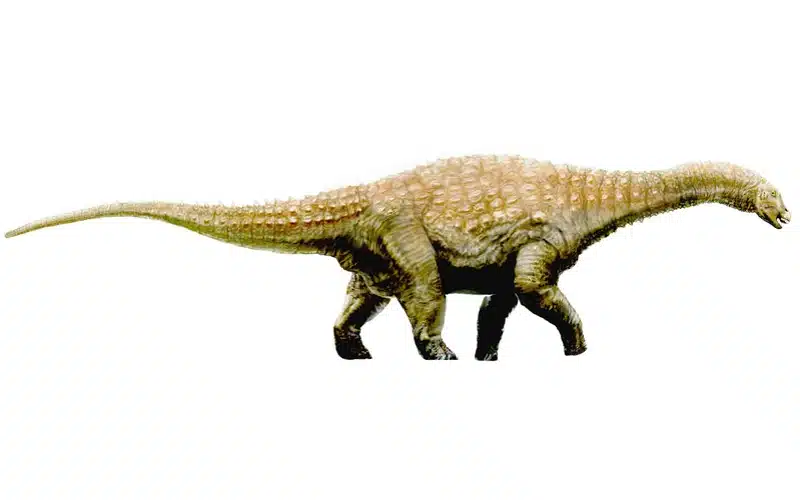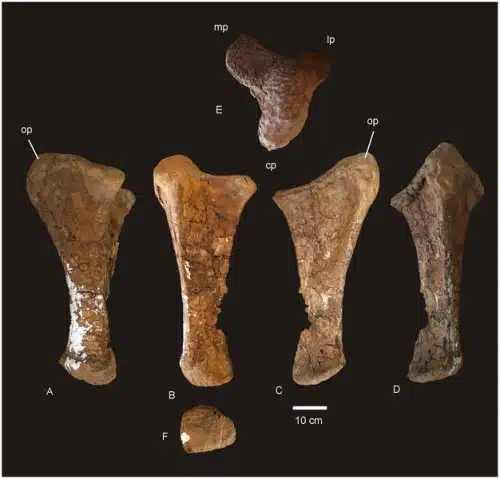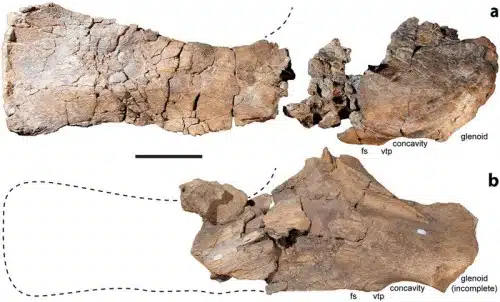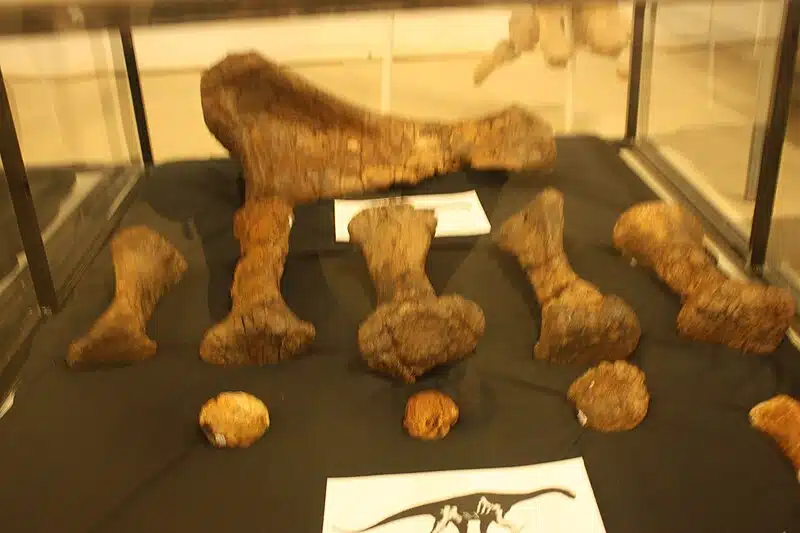Diamantinasaurus, named after the Diamantina River, was a giant herbivore from the Late Cretaceous Period of modern Australia. With its towering height and massive weight, this dinosaur was one of the titans of its time.
The first remains where excavated between 2006 and 2010, Diamantinasaurus provides a captivating glimpse into the diverse and complex world of dinosaurs. Its discovery has added significant knowledge to our understanding of sauropods and their evolution during the Cretaceous Period.
Diamantinasaurus Key Facts
| Keyword | Fact |
|---|---|
| Pronunciation | DEE-uh-man-TEE-nuh-SORE-us |
| Meaning of name | Diamantina Lizard |
| Group | Sauropoda |
| Type Species | Diamantinasaurus matildae |
| Diet | Herbivore |
| When it Lived | 99.6 to 95 MYA |
| Period | Late Cretaceous |
| Epoch | Cenomanian |
| Length | 52.0 ft |
| Height | 10.0 to 13.0 ft |
| Weight | 15.0 to 28.0 tons |
| Mobility | Moved on all four |
| First Discovery | 2000’s by Dr. Scott Hocknull and team |
| Described by | 2009 by Scott Hocknull, Matt White, Travis Tischler, Alex Cook, Naomi Calleja, Trish Sloan, David A. Elliott |
| Holotype | AODF 0603 ‘Matilda’ |
| Location of first find | Elderslie Station, near Winton, Queensland, Australia |
Diamantinasaurus Origins, Taxonomy and Timeline
Diamantinasaurus, whose name translates to “Diamantina lizard,” is a nod to the nearby Diamantina River in Queensland, Australia. This river runs close to where the first fossils were uncovered. The latter part of its name, “sauros,” is derived from the Greek word for lizard, emphasizing its reptilian nature.
Taxonomically, Diamantinasaurus belongs to the Sauropoda, more specifically within the titanosaurs. This family is renowned for its colossal members, which roamed various parts of the globe. The genus Diamantinasaurus includes the type species Diamantinasaurus matildae, named in 2009 by a group led by Dr. Scott Hocknull. There are no subspecies currently identified under this genus.

This giant roamed the Earth during the Late Cretaceous Period, particularly in the Late Cenomanian Epoch (95 to 93.5 Ma, according to zircon-dated elements). This era was a dynamic time in Earth’s history, characterized by significant changes in climate and sea levels, which in turn affected the flora and fauna of the period.
Listen to Pronunciation
To listen to the correct pronunciation of this dino’s name, check out this video.
Discovery & Fossil Evidence
The first fossils of Diamantinasaurus were unearthed during five dig seasons between 2006 and 2010 at the ‘Matilda Site’ on Elderslie Station, about 60 km northwest of Winton in western Central Queensland, Australia. The deposit is associated with several other tetrapod remains in a channel/riverbank deposit. This significant find was led by Dr. Scott Hocknull and his team, who meticulously excavated and analyzed the remains. In 2009, their hard work culminated in the formal description of the species Diamantinasaurus matildae.
The holotype specimen, designated as AODF 0603 and affectionately named ‘Matilda,’ included partial remains such as bones of the limbs, vertebrae, and ribs. These well-preserved fossils provided critical insights into the dinosaur’s physical structure and lifestyle. Additional skeletal elements such as the right coracoid, right radius and manus elements have been later added to the original specimen.
Three additional specimens, including one juvenile, have been found and described since 2009.
Examining these fossils, scientists have been able to piece together the anatomy, size, and probable behavior of Diamantinasaurus, shedding light on its role within its ecosystem.
- Ulna of Diamantinasaurus matildae.
- Scapulae of Diamantinasaurus matildae
- Diamantinasaurus foot
- Astragalus of Diamantinasaurus matildae.
Diamantinasaurus Size and Description
Diamantinasaurus was a true giant of its time, with a physical structure that embodied the typical traits of sauropods.
Short Description of Diamantinasaurus
This dinosaur had a robust body supported by four massive, pillar-like legs, typical of sauropods. Its long neck allowed it to reach high into trees for foliage, while its relatively small head housed a mouth adapted for stripping leaves. The vertebrae were sturdy, providing support for its immense weight, and the tail was long and whip-like, likely used for balance and possibly defence. Diamantinasaurus moved on all four legs, which were built for stability rather than speed.
Size and Weight of Type Species

Estimates suggest that Diamantinasaurus reached a length of approximately 52.0 feet, making it one of the larger sauropods of its time. Its height ranged from 10.0 to 13.0 feet at the shoulders, providing it with a significant vantage point over the landscape. The weight of this giant was immense, with estimates ranging between 15.0 and 28.0 tons. Such massive dimensions would have required a vast amount of vegetation to sustain its herbivorous diet.
The Dinosaur in Detail
What sets Diamantinasaurus apart are its unique features, which have been meticulously studied from the available fossil evidence. Its robust limbs and solid vertebrae indicate a creature built for supporting significant weight, highlighting its evolutionary adaptations for survival. One anatomical feature to note is that the centrum of the caudal vertebrae are amphicoelous (both anterior and posterior surfaces are concave). The structure of its limbs suggests it could navigate various terrains, from dense forests to open plains, where it would graze on abundant plant life.
The skull was fully CT-scanned and a 3D model was produced. The nares are large and are separated by a narial bar. The antorbital fenestra is small and oval; and the supratemporal fenestra is rather large. The maxilla holds 9 alveoli (tooth sockets), which is fewer than most titanosaurs. The parietal, which contributes to the supratemporal fenetra, is concave on its anterior surface and convex on its posterior section. In the inner ear, the lateral and the posterior semicircular canals define an angle of 130 degrees. The quadratojugal and the quadrate (that forms the mandibular articulation), possess a horizontal ridge anterior to their articulation
Contemporary Dinosaurs
Several other dinosaur species shared Diamantinasaurus’ habitat, each contributing to the dynamic ecosystem of the Late Cretaceous Period. All specimen listed below come from the Winton Formation in Australia.
Wintonotitan, a massive sauropod, coexisted with Diamantinasaurus. Then there was Savannasaurus, a titanosaur. These giants would have likely competed for the same types of vegetation, shaping their feeding behaviors and territorial dynamics. The presence of multiple large herbivores suggests a landscape rich in plant life, capable of supporting these colossal creatures.
Australovenator, a smaller but formidable predator, was discovered on the same site than Diamantinasuaurs. Unlike the herbivorous sauropods, Australovenator was a carnivore, likely preying on smaller dinosaurs and possibly scavenging. Its presence indicates a complex food web where different species occupy various ecological niches.
Interesting Points about Diamantinasaurus
- Unique Name Origin: Named after the Diamantina River, it reflects the local geography of its discovery.
- Robust Limbs: Built to support its massive weight, its limbs are a hallmark of its evolutionary success.
- Diet Adaptations: As a herbivore, its long neck allowed it to feed on high vegetation that other dinosaurs couldn’t reach.
- Coexistence with Predators: Shared its habitat with the carnivorous Australovenator, highlighting a diverse ecosystem.
- Well-preserved Specimen: The type specimen ‘Matilda’ provides extensive insights into its anatomy and lifestyle. Three other specimens have been since desccribed in the literature.
Diamantinasaurus in its Natural Habitat
The environment in which Diamantinasaurus lived was vastly different from modern-day Australia. During the Late Cretaceous Period, the climate was warmer and more humid, supporting lush forests and abundant plant life. This type of vegetation was crucial for a giant herbivore like Diamantinasaurus, which required vast amounts of food to sustain its massive body.
As a herbivore, Diamantinasaurus primarily fed on high-growing vegetation, which it could reach with its long neck. Its diet would have consisted of a variety of plants, contributing to the shaping of its habitat. The competition for food with other large herbivores like Wintonotitan and Savannasaurus also played a role in the distribution of plant life in its environment.
Diamantinasaurus likely moved in herds, a common behavior among large sauropods, providing protection from predators and ensuring efficient foraging. Its massive size and the potential whip-like tail suggest it had few predators, though it might have used its tail for defense if necessary. This dinosaur’s presence would have influenced the ecosystem significantly, from shaping the vegetation structure to impacting the behavior of other species within its habitat.
Frequently Asked Questions
Diamantinasaurus was a herbivore, feeding primarily on high-growing vegetation in its lush, forested environment.
Diamantinasaurus reached about 52.0 feet in length and stood 10.0 to 13.0 feet tall at the shoulders, weighing between 15.0 to 28.0 tons.
It lived during the Late Cretaceous Period, specifically in the Late/Upper Cenomanian Epoch, around 99.6 to 93.5 million years ago.
The first fossils were discovered in the early 2000’s by a team led by Dr. Scott Hocknull at the ‘Matilda Site’ in Queensland, Australia.
Its name, derived from the Diamantina River, and its robust limbs designed to support its immense weight are some of its unique features.
It likely lived in herds, providing mutual protection and enhancing foraging efficiency in its prehistoric habitat.
Sources
The information in this article is based on various sources, drawing on scientific research, fossil evidence, and expert analysis. The aim is to provide a comprehensive and accurate overview of Diamantinasaurus. However, please be aware that our understanding of dinosaurs and their world is constantly evolving as new discoveries are made.
This article was last fact checked: Joey Arboleda, 06-17-2024
Featured Image Credit: Artwork: T. Tischler, Australian Age of Dinosaurs Museum of Natural History., CC BY 2.5, via Wikimedia Commons




